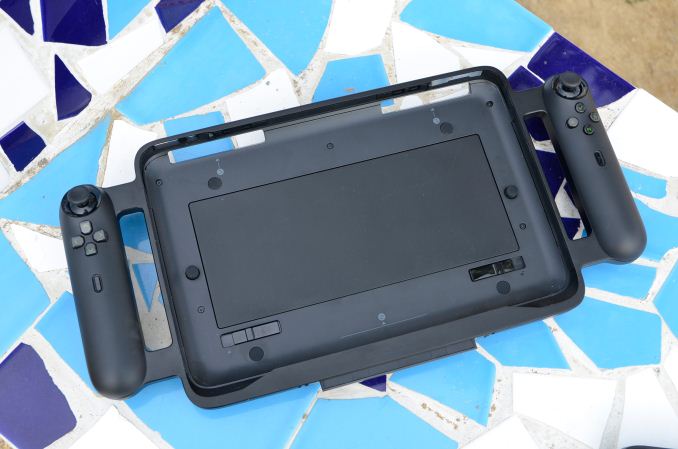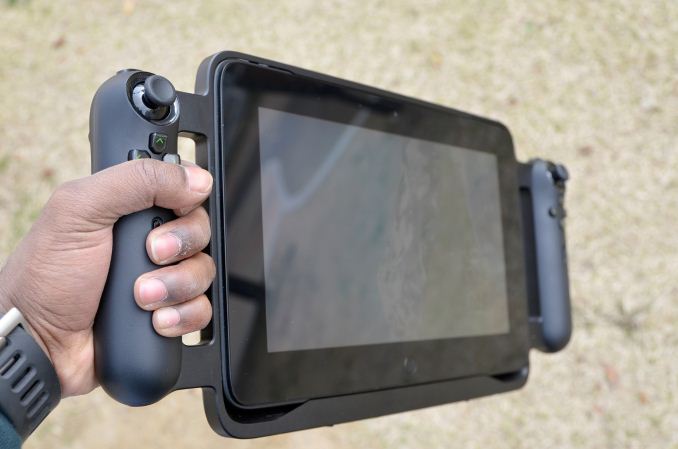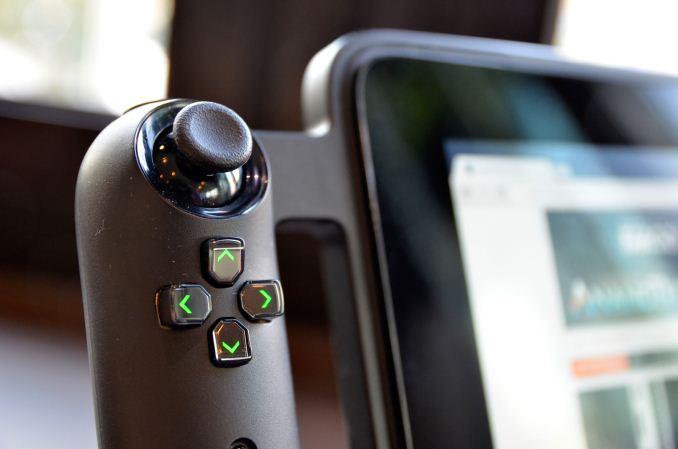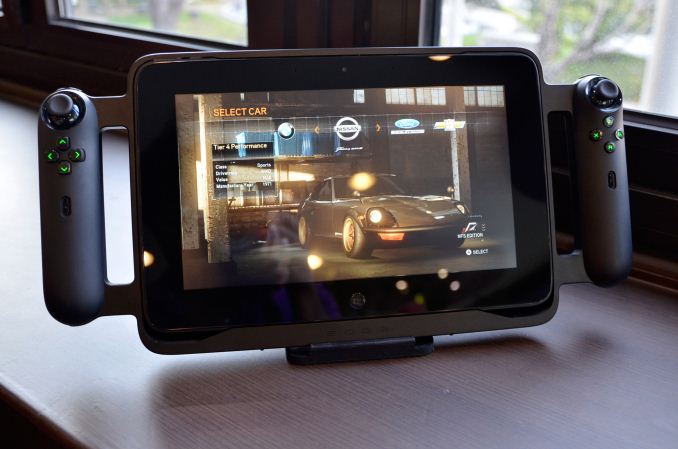The Razer Edge Review
by Vivek Gowri on March 28, 2013 11:00 AM EST- Posted in
- Tablets
- Mobile
- Razer
- Razer Edge
The Gamepad
The gamepad controller is obviously the game-changer here, since it really does redefine portable gaming usage models. That sounds like marketing hyperbole at first, but it’s actually true – you can take the Edge around with the gamepad and play real PC games on it basically anywhere, as though it’s a huge PSP or some crazy Ben Heck experiment to weld the two halves of an Xbox controller to a tablet. It’s simply awesome, there’s absolutely no question in my mind about that.
The gamepad controller is like a case that the Edge docks into, with a springloaded clip with the dock connector and two pins on either side to hold it in place. The inner surface of the gamepad features two rubber pads with springs behind them to pop the tablet up out of the case when the clip is released. Inserting and removing the tablet from the gamepad is a two-hand job, as both sides of the bottom clip need to be released before the tablet pops up.
The frame is made of anodized aluminum, with the controls and backplate being matte black plastic that looks very similar to the aluminum in terms of aesthetic. Everything attaches to the aluminum skeleton though, so the entire piece feels very solid in your hands. It actually reminds me a bit of the controller cases for iPhone that turned it into something resembling a high-tech Gameboy. The frame has contours on the inner bottom edge, redirecting output from the downward-firing speakers out towards the user.
With the extended 41.44Wh battery, the full kit weighs about 3.25 pounds. Ergonomically, this is a two-handed device – there’s too much weight and holding just one handle won’t work due to the rotational moment of inertia. Basically, it just wants to rotate around the axis of the handle unless you’re holding both of them. The weight means that the easiest way to game is to place the back of the tablet on your lap and just crane over it to play. It just isn’t feasible to hold upright for any sustained period of time without resting it against something. The IPS panel helps with the viewing angles, so thankfully that isn’t an issue. The nice thing about the gamepad controller is that it does shield the worst of the heat – the top right corner of the gamepad does get pretty toasty when gaming or benchmarking for a length of time, but it’s not as bad as touching the tablet directly.
The controller has two analog sticks prominently featured at the top of each side, directional buttons on and a back button on the left side, the four action buttons (A, B, X, Y) and start button on the right side, two sets of right and left shoulder/bumper buttons, and two analog triggers. It has basically the same controller layout as the Xbox 360, with one key difference – the right analog stick is placed above the action buttons instead of below. This is a little annoying, because the natural instinct is to put your thumb on the analog instead of the action buttons where they would normally be. If you don’t adjust the position of your hand on the right side, this can result in discomfort during extended gaming sessions (yes, I know this from experience.)
The system recognizes the gamepad as an Xbox 360 controller, so there are no questions about compatibility or setup. It just works. You can even install JoyToKey to emulate a mouse using the analog sticks, though I wish Razer had included a first-party way to do this. When properly set up, it’s pretty interesting to use the gamepad for standard Windows input.
In general, the Edge’s gamepad controller shockingly simple to use and easy to get used to, the adjustment isn’t nearly as much as one would think considering that your Xbox controller has suddenly mutated and grown a 10.1” display. You start playing games everywhere – buses, cars, planes, coffee shops, subways, libraries, basically anywhere you can pull out a tablet. Early on in the review process, I was driving to dinner with a friend of mine who was playing Half-Life 2 on the Edge in the passenger seat. It was incredibly distracting, mostly because I really wanted to play too. (A small piece of advice: don’t drive and play Need For Speed during stoplights, regardless of how tempting it might be to do so.) But it’s awesome – places where it would be awkward or impossible to play PC games are no longer so, you can just take the Edge and play Skyrim or Dirt 3 as easily as one would play Angry Birds on an iPad. Bam, mobile PC gaming, redefined.














89 Comments
View All Comments
A5 - Thursday, March 28, 2013 - link
It seems like the 2nd generation of this will be way better, if what half of Intel is saying about Haswell and GT3e is true.VivekGowri - Thursday, March 28, 2013 - link
That's something I wanted to touch on in the conclusion but ran out of time/forgot: GT3e will make the second generation of this really, really interesting. Haswell/GT3e is going to be an awesome combination, but like Anand tweeted, it'll be a while (14nm in 2015) until we get a real best of both worlds solution.A5 - Thursday, March 28, 2013 - link
Yeah, it seems that way. Thanks for the reply.tech.noob.fella - Friday, March 29, 2013 - link
isnt gt3 only for desktops?? i thought gt2 was for portables like this machine...not sure thoughKristian Vättö - Friday, March 29, 2013 - link
GT3 is for laptops too (and even the GT3e). Intel has always focused the best IGPs to mobile CPUs because those systems are the most likely to only feature integrated graphics. Desktops often have a dGPU because there's no heat/space/battery issue, especially if the system is geared towards something graphics intensive (IGPs, even lower-end ones, are fine for basic use).TerdFerguson - Thursday, March 28, 2013 - link
I find this review to be overly generous. Hardware should be reviewed on its merits, not on whether or not you approve of the concept. Asking nearly $2k for this monstrosity is utterly unreasonable.VivekGowri - Thursday, March 28, 2013 - link
It starts at $999, and the most reasonable configuration is $1499 - this honestly isn't that much more than Surface Pro or any of the other high-end Windows 8 tablets. I'd much, much rather pay $1499 for Edge Pro + gamepad than $1199 for the ATIV Smart PC Pro + laptop dock. Surface Pro plus Type Cover for $1139 is probably an equally decent value, but significantly slower (i5/HD4000/4GB vs i7/GT640MLE/8GB) and plays in a completely different market.andrewaggb - Thursday, March 28, 2013 - link
The docks are still the killers for me. At a desk I want to run 2 monitors at 1080p each minimum, preferrably with both 1920x1200 or better. And a usb keyboard and mouse. I could have a dock setup like that at the work office and home office and just drop the tablet in wherever I'm at. Wouldn't care if the tablet screen was disabled when docked running 2 external displays.I would also like a transformer style keyboard dock so I could use it as a laptop.
When I can do all that, with an i7/8gb/256gb+ ssd, it will be sweet. It sucks because I'm sure it could be done now and nobody seems to have done it. Hopefully with haswell... but everybody keeps talking about haswell like it's the second coming, I'm worried it's not going to live up to our expectations.
zanon - Thursday, March 28, 2013 - link
Vivek mentioned Tb, and what you describe is one of the few areas where it'd be really interesting. The dock could itself have a standard graphics card, and thus drive multiple large screens and more powerful gaming while still allowing the tablet part to get away with much less graphics power.15th Warlock - Thursday, March 28, 2013 - link
I have to agree with Terd, while $999 may be the prize of entrance for the Edge experience, the review doesn't actually test the default battery configuration (regardless of it being the pro or non pro version).What this review shows us is a best scenario, using the $250 gamepad attachment and $70 extra battery, that's $320 over the original MSRP, so, even in this scenario you only get 2 hrs of gaming when not plugged to the wall.
The review fails to mention that out of the box this tablet offers only one hour of gaming, and perhaps, less than 3 hrs. of regular use, if razer offered the extra battery with the gamepad attachment it would be a more tolerable proposal, but nickel and diming gamers for the privilege to play for two hrs is way too much, not even Apple limits the user experience in such a way with their overpriced toys...